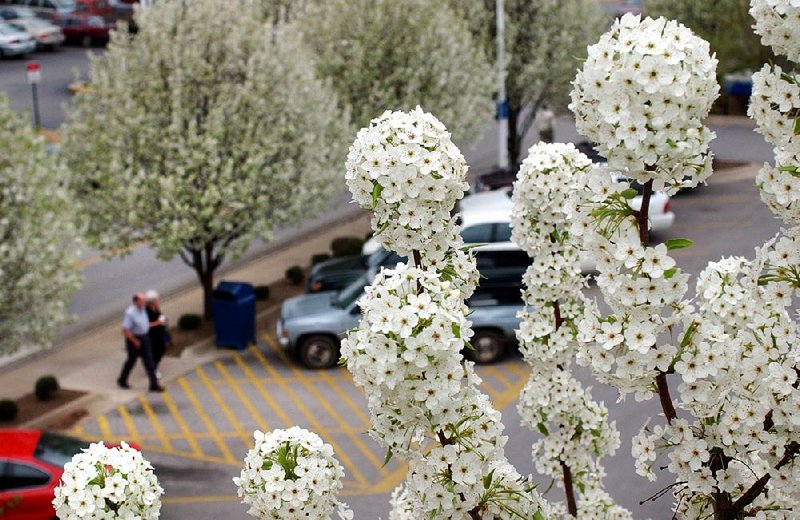Dear Otus,
We moved here from Minnesota and this is our first spring in the Natural State. Our neighbors tell us you're the best one to ask about these gorgeous trees that have exploded into white overnight. Can we still plant them this year?
-- the Nykommeres,
Bella Vista
•••
Dear Otus,
As much as I'm glad to see the ice and snow end, I always dread the annual blooming of the insidious Bradford pears. They smell and herald the onset of the nasty pollen season. Can't we just cut them all down?
-- Erwinia Amy Lovora,
Little Rock
Dear Erwinia and Nykommeres,
It was wholly a pleasure to hear from you all and to have the opportunity to admonish Arkansans, new and established, to eschew the temptation to import more of this invasive species no matter how pretty they may seem for a couple of weeks in the spring.
I'm siding with Erwinia on this one.
The Bradford pear is a cultivar of the Callery pear (Pryus calleryana), which was first imported from China and Vietnam in 1909 by well-meaning botanists who believed cross pollination would be the answer to fire blight.
Fire blight is a contagious disease caused by an insect-borne pathogen from a virulent bacterium in the family Enterobacteriaceae.
Common pears are especially susceptible, but apples, loquat, crabapples, quinces, hawthorn, cotoneaster, pyracantha, raspberry and some other rosaceous plants are also vulnerable.
In the early 20th century, it seemed the Callery pear was the quick and easy solution to the problem.
Yeah, and kudzu was an easy ornamental solution to erosion across the South.
And Asian carp were imported to Arkansas in the 1970s to help aquaculture and wastewater treatment facilities keep retention ponds clean. They escaped and are on the verge of taking over the Great Lakes.
And privet hedges! Don't get me started. They seem harmless when trimmed to form a nice, trim boundary between your yard and the neighbors'. But the seeds, having traveled through a bird's digestive tract unharmed, have gone wild and choked out vast areas of native plants because it can reproduce asexually through root suckers.
You want to see privet at its worst -- fully 38 percent of the Holla Bend National Wildlife Refuge southeast of Dardanelle is now a vast, impenetrable, privet quagmire.
Nobody thought of all of that when they imported the privet for ornamentation. And nobody thought of the negative effects of Bradford pears when they became the darlings of ornamental landscapers around 1950. They were cheap, quickly growing and lovely in the spring and fall.
The Callery pear was named for the Catholic missionary and sinologue Joseph-Marie Callery (1810--1862), and the Bradford was named for Frederick Charles Bradford, the director of the agriculture department station in Maryland where the pear was developed.
In light of the suspicion that Bradford was a Commie dupe and fellow traveler, his legacy has been tarnished and his portrait removed from the Cultivar Hall of Fame in Bethesda, Md.
Because of Bradford, some now speculate the Callery was a calculated, long-term experiment by the Chinese Communists to destroy American olfactory senses. The Bradford pear is one of several cultivars of the Callery pear capable of spreading and being invasive.
Within a few decades, fully half the eastern United States -- from New Jersey to Illinois to Texas -- was hip-deep in Bradfords to the detriment of native species.
It wouldn't be so bad if we could eat the "pears" from Bradford pears. However, the small, grape-size fruit is tough and tastes like tennis shoes.
What's worse is that the weak branching structure of the Bradford means that once a tree is mature and in its full glory, even a moderate storm can shatter branches and destroy thousands of dollars in landscaping.
And, Erwinia, you mentioned the smell. Indeed. The pungent, overpowering aroma of the Bradford during its flowering stage has been described as reminiscent of rotting fish, curdled milk, spoiled tofu, chlorine or a bodily fluid that we'll not go into in this space.
Joggers and small pets on a leash have been known to keel over while passing beneath an arbor of flowering Bradfords.
One wonders why the watchdogs ignored the tree's nicknames in 1950: Satan's snuffbox; the Tempter's talcum; Lucifer's lollipop; the Devil's dandruff; Perdition's Periwinkle; Beelzebub's blossoms.
Until next time, Kalaka says that if we work together, we can nip all these Bradford pears in the bud.
Disclaimer
Fayetteville-born Otus the Head Cat's award-winning column of humorous fabrication appears every Saturday. Email:
mstorey@arkansasonline.com
HomeStyle on 03/28/2015
